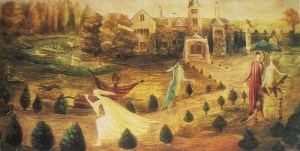Beginnings
“One has to be careful what one takes when one goes away forever.” – Leonora Carrington
“Then I started seeing how the transcendent would almost always creep into the everyday.” – Alison Bechdel
The summer’s just begun and it’s finally raining in Texas. I’m in that brief period between a spring semester and a summer term, between ending an old job and beginning a new one. It’s almost time to change apartments too. So in a middle of transition, on shifting, slightly muddy ground, I’m finally getting my feet back under me. I’m writing, both fiction and poetry. None of it is terribly good, but that’s alright. It’s happening and the good always shows up eventually.
I found a new apartment today. It’s on the east side of town, where girls with dirty shoulders and elbows ride around on gleaming bicycles with their tattoos bared like poly-chromatic teeth. I went alone after work to see the place, vaguely aware of all the fears and paranoias I was nibbling at the underbelly of my mind. You shouldn’t go alone. You could get raped. You should designate someone to check in with. But I pushed them aside. I had a good feeling in my belly, so I drove over the freeway to Eastside.
I passed over the highway which was crammed with cars going both north and south. Once on the Eastside the trees immediately enveloped me and the sound of the highway was gone. To the right of the road was large shady cemetery with grey headstones springing like mushrooms from the grass. I passed by dozens of clapboard houses, built in that 1920s style that seems to make up so much of this city’s older neighborhoods. All small and modest, in colors as temperate as a country preacher’s handkerchiefs, but weird too — blue painted wagon wheels set out in the grass, fountain shrines to headless Virgins, piebald dogs and slim blue-eyed cats slinking through chicken wire gardens.
The building was off the main road, gated and faced with stone and wheel-barrow-red wood. Potted plants spilled tendrils through the banisters. The apartment was small and low ceilinged with walls the green of locusts. On the walls were dozens of portraits of Frida Kahlo. Her “Self-Portrait with Monkey” had been enhanced so that the monkeys’ faces protruded from the frame. I was shown through all the room by a man with long yellow hair, but I didn’t need to see it. Not really. As soon as I saw the green walls, I knew it was mine. I am the kind of person who falls in love at first sight, or not at all.
Yesterday I finished Amulet by Roberto Bolaño. In the book, the heroine, Auxilio Lacouture does and does not meet the surrealist painter Leonora Carrington. Carrington shows the woman into her home with walls the green of locusts. Auxilio, the half-mad, usually homeless, Mother of Mexican Poetry, is star-struck. She babbles like a school-girl to Carrington about her paintings, which she loved, each one at first sight.
Today at work, someone returned two books of fine quality prints of Leonora Carrington’s paintings (I work at a library). I spent most of my shift sipping coffee and flipping the pages, staring into the mind of Leonora Carrington, as Auxilio LaCouture must have stared into her paintings in Mexico City, as Roberto Bolano must have stared into the mind of Auxilio LaCouture while staring into the blank white document of his word processor, just as I am staring now.
I thought again about the apartment with its locust green walls. I could picture my desk in front of one of those windows, the bookshelves on either side and the green underbellies of the leaves on the other side of the glass. I could see myself standing into the blank white document of a word processor. I could see myself writing.

